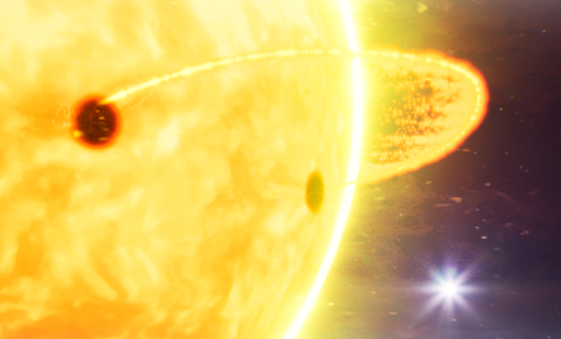Main Sequence
-
Houdini Solar Flares
Particles generated in Houdini were exported into UE5, acting as the star's solar flares.
-
Dynamic Niagara Effects
Spline Paths with Niagara systems generated solar flares whilst other systems created the outer atmosphere of the star.
-
Sequencer Transition
Seamless transition between the Protostar Niagara Fluid system to a Mesh Based Material.
This third stage follows a seamless transition from the Protostar fluids, with a whole host of effects and shader parameters to make this scene immersive, realistic and engaging.
Houdini Magnetic Field
Initial development began with a physically based simulation in Houdini, which successfully built a dynamic magnetic field using particle polarity, where individual particles were coded to have positive and negative charges, accurately representing a magnetic field. Whilst this effect was achieved, acting as an authentic depiction of solar dynamics, the continuation of the series used as inspiration was gated behind a paywall and thus the method had to be discontinued.
Houdini Solar Flares
A second Houdini approach aimed to procedurally generate a large proportion of the main sequence. This setup used a combination of noise fields, particle advection and velocity manipulation, creating the effects of the moving surface of a sun alongside large solar winds shot out from the surface. Whilst this effect worked seamlessly in Houdini, upon exporting the simulation to UE5 via the Houdini Niagara Plugin, the simulation was simply too large for UE5 to import and process.
As a result, the simulation was heavily simplified by drastically reducing the particle count and resolution, as shown by the second video.
Rather than discarding this effect, it was instead repurposed to function as solar wind and contributing to the atmospheric environment around the star rather than the main star itself. This simulation was iterated several times and used Mantra to preview the simulation in Houdini before exporting to UE5.
Solar Flares
Synonymous with main sequence stars are solar flares. Several techniques were prototyped however were very quickly discarded for this approach. This method involves generating a spline that replicates the arcing motion of solar flares and creating a particle system which is set to follow this path. Two different spline paths were created and rotated to keep visual interest. The choice to have one long spline for several solar flares is simply for optimisation purposes. Rather than having seven different solar flare particle systems at once, one particle system is used for all seven, significantly increasing performance.
Based on real world observations of solar flares on our sun, it was found that sunspots typically form at points were solar flares emerge and re-enter the sun. Given the amount of sunspots that were going to be needed throughout the simulation, the most efficient and performance-optimized solution was to use simple planes with circular materials that were meticulously translated as the sequence evolved to display magnetic activity on the star’s surface.
Finally, with an added Niagara System surrounding the star to convey the intense outer atmosphere, all the elements come together to create a visually compelling Main Sequence Star, based on scientifically accurate observations.



